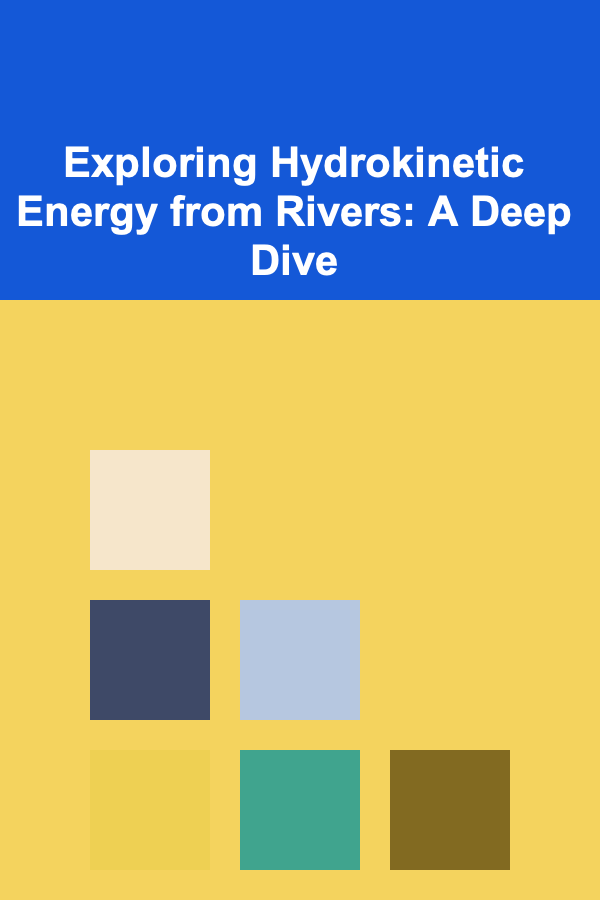
Exploring Hydrokinetic Energy from Rivers: A Deep Dive
ebook include PDF & Audio bundle (Micro Guide)
$12.99$8.99
Limited Time Offer! Order within the next:

Hydrokinetic energy, the energy harnessed from the kinetic energy of flowing water in rivers, canals, and tides, presents a compelling and increasingly viable alternative energy source. Unlike traditional hydroelectric power, which relies on dams to create large reservoirs and head differences, hydrokinetic technologies can extract energy from free-flowing water without significantly altering the natural river environment. This makes it a potentially more environmentally friendly and sustainable option, particularly in regions where large-scale dam construction is impractical or undesirable.
Understanding Hydrokinetic Energy
The fundamental principle behind hydrokinetic energy harvesting is converting the kinetic energy of moving water into mechanical energy, which is then converted into electrical energy. This process relies on various device designs, each optimized for specific flow conditions and river characteristics. The power available in flowing water is directly proportional to the cube of the water's velocity, highlighting the importance of site selection and device efficiency.
Mathematically, the power available in a flowing stream can be expressed as:
P = (1/2) * ρ * A * v^3^
Where:
- P = Power (Watts)
- ρ = Density of water (approximately 1000 kg/m^3^)
- A = Cross-sectional area of the flow intercepted by the device (m^2^)
- v = Velocity of the water (m/s)
This equation underscores the critical role of water velocity in determining the potential power output. Even small increases in velocity can significantly boost the available energy. However, extracting this energy efficiently and sustainably requires careful consideration of device design, placement, and environmental impacts.
Types of Hydrokinetic Turbines and Devices
Several types of hydrokinetic turbines and devices are being developed and deployed to harness river energy. These can be broadly classified into the following categories:
1. Horizontal Axis Turbines (HATs)
HATs resemble underwater wind turbines, with blades rotating around a horizontal axis parallel to the flow of water. They are generally more efficient in unidirectional, relatively uniform flow conditions. However, they are susceptible to damage from debris and require careful alignment with the flow direction. Scale models have shown good performance and are currently being tested in various river environments. Examples include:
- Free Stream Turbines: Operate in open channels and are often mounted on floating platforms or submerged structures.
- Ducted Turbines: Enclose the turbine within a duct or shroud, which can concentrate the flow and increase efficiency. Ducts can also protect the turbine from debris.
2. Vertical Axis Turbines (VATs)
VATs, such as Darrieus and Savonius turbines, have blades that rotate around a vertical axis perpendicular to the flow. They are less sensitive to flow direction and can operate in turbulent or bidirectional flows. They are also generally simpler in design and easier to maintain. However, VATs typically have lower efficiency compared to HATs. Examples include:
- Darrieus Turbines: Utilize curved blades that capture energy from the flow.
- Savonius Turbines: Rely on drag forces to rotate the turbine, making them suitable for low-velocity flows.
3. Oscillating Hydrofoils
These devices use oscillating hydrofoils to generate lift and drag forces, which are then converted into electricity. They can operate in both unidirectional and bidirectional flows and are relatively compact. Oscillating hydrofoils are still in the early stages of development but hold promise for applications in tidal and river environments.
4. Venturi Systems
Venturi systems utilize a constricted channel to accelerate the flow of water, increasing the kinetic energy available for extraction. A turbine is placed within the constricted section to harness this increased energy. Venturi systems can be particularly effective in low-velocity environments.
The choice of turbine type depends on a variety of factors, including the river's flow characteristics, depth, width, sediment load, and regulatory requirements.
Site Assessment and Resource Characterization
Thorough site assessment and resource characterization are crucial for successful hydrokinetic energy development. This process involves collecting detailed data on river characteristics, including:
1. Flow Velocity
Measuring flow velocity is paramount. Accurate velocity data is essential for estimating the power potential and selecting the appropriate turbine design. Acoustic Doppler Current Profilers (ADCPs) are commonly used to measure velocity profiles across the river channel at various depths and times. Long-term monitoring is necessary to capture seasonal variations in flow rates.
2. Water Depth and Channel Geometry
Detailed bathymetric surveys are needed to map the riverbed topography and determine the water depth at different locations. This information is crucial for turbine placement and assessing the potential for scour and sedimentation.
3. Sediment Load
High sediment loads can cause abrasion and erosion of turbine blades, reducing their efficiency and lifespan. Analyzing sediment composition and concentration is essential for selecting appropriate materials and implementing mitigation measures.
4. Turbulence Intensity
Turbulence can affect turbine performance and stability. Measuring turbulence intensity helps in designing robust turbines that can withstand fluctuating flow conditions.
5. Debris Load
Debris such as logs, branches, and trash can damage turbines and reduce their efficiency. Assessing the debris load is important for designing protective measures and implementing debris removal strategies.
6. Water Quality
Water quality parameters such as pH, salinity, and dissolved oxygen levels can affect turbine corrosion and the overall health of the river ecosystem. Monitoring these parameters is important for ensuring the long-term sustainability of the project.
7. Environmental Considerations
A comprehensive environmental impact assessment (EIA) is essential to identify and mitigate potential impacts on aquatic life, riparian habitats, and water quality. This includes assessing the risk of fish entrainment, habitat disruption, and changes in flow patterns.
The data collected during site assessment should be used to develop a detailed resource characterization report that outlines the hydrokinetic energy potential of the site and identifies any potential challenges or constraints.
Environmental Considerations and Mitigation Strategies
While hydrokinetic energy is generally considered more environmentally friendly than traditional hydropower, it is crucial to address potential environmental impacts to ensure its sustainable development. Some key environmental considerations include:
1. Fish Entrainment and Mortality
Fish can be injured or killed if they come into contact with turbine blades. The risk of fish entrainment depends on the turbine design, blade rotation speed, and fish species present. Mitigation strategies include:
- Blade Design: Using slow-rotating, low-solidity blades can reduce the risk of injury.
- Fish Screens: Installing screens upstream of the turbines can prevent fish from entering the turbine area.
- Fish-Friendly Turbines: Developing turbines specifically designed to minimize fish entrainment.
- Operational Strategies: Modifying turbine operation during periods of high fish migration.
2. Habitat Disruption
Turbine installation and operation can disrupt aquatic habitats and alter flow patterns. Careful site selection and turbine placement are essential to minimize habitat disturbance. Mitigation strategies include:
- Avoiding Sensitive Areas: Siting turbines away from spawning grounds, migration corridors, and other critical habitats.
- Minimizing Infrastructure Footprint: Using minimally invasive installation techniques.
- Restoring Disturbed Areas: Replanting vegetation and restoring riverbanks to their natural state.
3. Sediment Transport
Turbines can alter sediment transport patterns, potentially leading to scour, sedimentation, and changes in river morphology. Monitoring sediment transport and implementing mitigation measures are necessary to prevent adverse effects. Mitigation strategies include:
- Turbine Placement: Placing turbines in areas with minimal impact on sediment transport.
- Sediment Management: Implementing sediment removal strategies to prevent buildup around turbines.
- Riverbank Stabilization: Protecting riverbanks from erosion.
4. Noise and Vibration
Turbine operation can generate noise and vibration, which may affect aquatic life. Minimizing noise and vibration levels is important for protecting sensitive species. Mitigation strategies include:
- Noise Dampening: Using noise dampening materials in turbine construction.
- Vibration Isolation: Isolating turbines from the riverbed to reduce vibration transmission.
- Monitoring Noise Levels: Regularly monitoring noise levels to ensure compliance with regulatory standards.
5. Water Quality Impacts
Turbine operation can potentially affect water quality, although the impacts are generally less significant than those associated with traditional hydropower. Monitoring water quality parameters and implementing best management practices are necessary to prevent adverse effects. Mitigation strategies include:
- Avoiding Oxygen Depletion: Ensuring adequate water flow around turbines to prevent oxygen depletion.
- Preventing Oil Leaks: Using environmentally friendly lubricants and implementing leak prevention measures.
- Controlling Erosion: Preventing erosion from turbine installation and operation to minimize sediment input into the river.
A comprehensive environmental monitoring plan should be developed and implemented to track the effectiveness of mitigation measures and ensure compliance with environmental regulations.
Technological Advancements and Future Directions
Hydrokinetic energy technology is rapidly evolving, with ongoing research and development focused on improving turbine efficiency, reducing costs, and minimizing environmental impacts. Some key areas of technological advancement include:
1. Advanced Turbine Designs
Researchers are exploring novel turbine designs that are more efficient, durable, and environmentally friendly. This includes:
- Biomimetic Designs: Inspired by the movements of fish and other aquatic organisms.
- Variable Pitch Blades: Blades that can adjust their angle to optimize performance in varying flow conditions.
- Modular Designs: Turbines that can be easily assembled and deployed in different configurations.
2. Materials Science
Developing new materials that are more resistant to corrosion, abrasion, and biofouling is crucial for extending turbine lifespan and reducing maintenance costs. This includes:
- Advanced Composites: Lightweight, high-strength materials that can withstand harsh river environments.
- Self-Healing Coatings: Coatings that can repair minor damage and prevent corrosion.
- Biofouling-Resistant Materials: Materials that prevent the growth of algae and other organisms on turbine surfaces.
3. Power Electronics and Grid Integration
Improving power electronics and grid integration technologies is essential for efficiently converting the energy generated by hydrokinetic turbines and delivering it to the grid. This includes:
- Advanced Power Converters: Devices that can convert the variable output of hydrokinetic turbines into stable, grid-compatible electricity.
- Smart Grid Technologies: Technologies that can manage the intermittent nature of hydrokinetic energy and integrate it seamlessly into the grid.
- Microgrids: Localized power grids that can utilize hydrokinetic energy to provide electricity to remote communities.
4. Predictive Modeling and Optimization
Developing sophisticated predictive models and optimization algorithms can help to improve turbine performance and optimize site selection. This includes:
- Computational Fluid Dynamics (CFD): Simulations that can predict turbine performance in different flow conditions.
- Machine Learning: Algorithms that can learn from operational data and optimize turbine performance in real-time.
- Geographic Information Systems (GIS): Tools that can identify suitable sites for hydrokinetic energy development based on various environmental and economic factors.
5. Remote Monitoring and Control
Implementing remote monitoring and control systems can reduce maintenance costs and improve turbine reliability. This includes:
- Sensors and Data Acquisition Systems: Systems that can collect data on turbine performance, environmental conditions, and grid parameters.
- Wireless Communication Technologies: Technologies that can transmit data from turbines to a central monitoring station.
- Automated Control Systems: Systems that can automatically adjust turbine operation based on real-time conditions.
Continued innovation in these areas is essential for unlocking the full potential of hydrokinetic energy and making it a competitive and sustainable energy source.
Economic Feasibility and Policy Support
The economic feasibility of hydrokinetic energy projects depends on a variety of factors, including turbine cost, installation cost, operating cost, and the price of electricity. Currently, hydrokinetic energy is generally more expensive than other renewable energy sources such as wind and solar. However, costs are expected to decrease as technology matures and deployment scales up.
Government policies and incentives can play a crucial role in promoting the development of hydrokinetic energy. Some key policy measures include:
1. Feed-in Tariffs (FITs)
FITs provide a guaranteed price for electricity generated from hydrokinetic energy, making it more attractive to investors.
2. Tax Credits and Grants
Tax credits and grants can reduce the upfront costs of hydrokinetic energy projects, making them more economically viable.
3. Renewable Energy Standards (RES)
RES require utilities to obtain a certain percentage of their electricity from renewable sources, creating a demand for hydrokinetic energy.
4. Streamlined Permitting Processes
Streamlining the permitting process can reduce the time and cost associated with developing hydrokinetic energy projects.
5. Research and Development Funding
Providing funding for research and development can accelerate technological innovation and reduce the cost of hydrokinetic energy.
A supportive policy environment is essential for attracting investment and driving the growth of the hydrokinetic energy industry.
Conclusion
Hydrokinetic energy from rivers offers a promising avenue for sustainable energy generation, particularly in regions with abundant flowing water resources. While challenges remain in terms of technology development, environmental impact mitigation, and economic feasibility, continued research, innovation, and supportive policies are paving the way for wider adoption. By carefully considering site characteristics, selecting appropriate turbine designs, implementing effective mitigation strategies, and fostering a favorable policy environment, we can unlock the full potential of hydrokinetic energy and contribute to a cleaner and more sustainable energy future.
The exploration and exploitation of hydrokinetic energy are not just about generating electricity; they represent a commitment to responsible resource management and a sustainable relationship with our natural environment. As we continue to refine and deploy these technologies, we move closer to a future where rivers can provide power without compromising their ecological integrity.
Reading More From Our Other Websites
- [Reading Habit Tip 101] Best Habits for Leveraging Micro‑Reading Moments During Coffee Breaks and Waiting Periods
- [Organization Tip 101] How to Use Monthly Boxes for Rotating Supplies
- [Personal Care Tips 101] How to Exfoliate Sensitive Skin with a Body Scrub
- [Home Family Activity 101] How to Collaborate on a Family Art Project That Everyone Will Love
- [Personal Finance Management 101] How to Protect Your Finances During a Divorce
- [Personal Investment 101] How to Build a Scalable Passive Income Business with AI
- [Personal Financial Planning 101] How to Use a Roth IRA for Tax-Free Retirement Growth
- [Home Pet Care 101] How to Find a Certified Pet Sitter for Peace of Mind
- [Simple Life Tip 101] How to Simplify Your Digital Photo Library in Under Two Hours
- [Home Security 101] How to Secure Your Home's Perimeter with Fencing and Gates

How to Create a Checklist for Website Security Maintenance
Read More
How to Plan a Backyard Campout for Quality Family Time
Read More
Mastering the Art of Customer Service: A Comprehensive Guide for Call Center Representatives
Read More
Understanding Company Values During Your Job Search
Read More
How to Organize Digital Homeschool Resources
Read More
How to Develop a Social Media Promotion Checklist for Blog Posts
Read MoreOther Products

How to Create a Checklist for Website Security Maintenance
Read More
How to Plan a Backyard Campout for Quality Family Time
Read More
Mastering the Art of Customer Service: A Comprehensive Guide for Call Center Representatives
Read More
Understanding Company Values During Your Job Search
Read More
How to Organize Digital Homeschool Resources
Read More